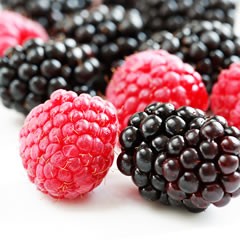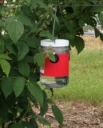Raspberries / Blackberries
 Raspberries are the most widely grown bramble crop in New York planted on over 450 acres in all regions of the state. Both floricane (summer bearing) and primocane (fall or ever-bearing) raspberries are grown and yellow, purple and black fruited cultivars in addition to the popular red raspberries make up the tasty crop. Ninety percent of the estimated 1.1 million pound annual raspberry crop is sold for fresh market and the remaining 10% is used to make value added items including preserves, juice additives and fruit wine.
Raspberries are the most widely grown bramble crop in New York planted on over 450 acres in all regions of the state. Both floricane (summer bearing) and primocane (fall or ever-bearing) raspberries are grown and yellow, purple and black fruited cultivars in addition to the popular red raspberries make up the tasty crop. Ninety percent of the estimated 1.1 million pound annual raspberry crop is sold for fresh market and the remaining 10% is used to make value added items including preserves, juice additives and fruit wine.Blackberries are closely related to raspberries and are grouped together with them in the 'Bramble' category of berry crops. Blackberries differ from raspberries in that the receptacle within the berry fruit is eaten along with the berry. For raspberries, the receptacle is left on the plant, leaving a hollow berry for consumption. Blackberries are also a more tender plant, successfully grown on 450 acres in more temperate regions of the state including Long Island, the Hudson Valley, the Finger Lakes region and fruiting districts near the Great Lakes.
All bramble crops need well drained soil as they are susceptible to soil borne diseases particularly Phytophthora. Potential growers should be aware of cane diseases and other pest problems, as well as the fact that raspberries and blackberries have an extremely short shelf life after harvest, making adequate post-harvest cooling essential. Brambles are often trellised adding to the production costs which can average about $4000/acre.
High tunnel production of raspberries and blackberries has been increasing throughout New York State thanks to research done by the Cornell University Department of Horticulture. This type of protected culture allows growers to extend the productive season of raspberries, extend the potential production sites of blackberries throughout the state and allows growers to produce a much higher quality fruit.
For more information about bramble culture, visit the Cornell Berry website.
Relevant Events
2026 Cornell Winter Fruit Webinar Series
January 22, 2026 : Blueberry Pruning and Soil Health to Minimize Pests and Maximize Yield
January 29, 2026 : Cost of Production for Fruit Crops
February 12, 2026 : Fire Blight Management Updates
February 19, 2026 : Pink and Petal Fall Insecticides- Can We Strike the Right Balance?
March 12, 2026 : Inoculating Orchards with Mycorrhizal Fungi
March 19, 2026 : St. Peachtrick's Day - Cherry Pruning Strategies and Plum Varieties for the Northeast
2026 Northeast Extension Fruit Consortium Winter Webinar Series
February 4, 2026 : Management of Up and Coming Strawberry Diseases in the Northeastern United States
February 11, 2026 : Kiwiberry Production in the Northeast
February 18, 2026 : Heat Mitigation- Sunburn and Fruit Coloring
February 18, 2026 : The Dating Game- Updates in Lepidopteran Mating Disruption
March 4, 2026 : USEPA Endangered Species Act Strategies and Pesticide Use
March 11, 2026 : Practical Drought Management for Fruit Growers
Tree Fruit Scouting - Online Course
February 25, 2026 : Tree Fruit Scouting - Online Course
Labeled Insecticides for Control of Spotted Wing Drosophila in NY Berry Crops
Laura McDermott, Team Leader, Small Fruit and Vegetable Specialist
Eastern New York Commercial Horticulture
Labeled Insecticides for Control of Spotted Wing Drosophila in New York Berry Crops - Quick Guide
Updated May 2024
2023 Labeled Insecticides for Control of Spotted Wing Drosophila in NY Berries
Laura McDermott, Team Leader, Small Fruit and Vegetable Specialist
Eastern New York Commercial Horticulture
May 2023 - Labeled Insecticides for Control of Spotted Wing Drosophila in New York Berry Crops - Quick Guide
New York Berry Price Information - 2020
Laura McDermott, Team Leader, Small Fruit and Vegetable Specialist
Eastern New York Commercial Horticulture
Ninety-nine farms in 37 counties that are currently producing berries completed the survey. Although the number of returned surveys was lower when compared to the previous study conducted in 2018, the results are robust. The average berry acreage was 9 acres and the average total farm size 177 acres. The size distribution of berry acres is similar to that from the 2018 survey. A large majority of our respondents farmed other crops in addition to berries.
The survey results indicate the prices of berries in New York State increased across most marketing channels for each berry, although some exceptions exist. This is important to note as the entire berry season took place during the COVID-19 pandemic. In addition, approximately 80% of the farms reported having increased expenses to comply with the pandemic safety measures.
The prices that growers received ranged greatly. These likely depended on many factors, but producers selling their berries at a price significantly less than the average sales price found in the report may want to re-evaluate their prices for the good of the industry as a whole.
SWD Insecticides Quick Guide 2020
Laura McDermott, Team Leader, Small Fruit and Vegetable Specialist
Eastern New York Commercial Horticulture
June 2020 - Labeled Insecticides for Control of Spotted Wing Drosophila in New York Berry Crops - Quick Guide
Labeled Insecticides for Control of Spotted Wing Drosophila
Laura McDermott, Team Leader, Small Fruit and Vegetable Specialist
Eastern New York Commercial Horticulture

June 2018 - Labeled Insecticides for Control of Spotted Wing Drosophila in New York Berry Crops - Quick Guide
Early Season Weed Control in Berry Crops
Laura McDermott, Team Leader, Small Fruit and Vegetable Specialist
Eastern New York Commercial Horticulture
2018 Eastern New York Fruit & Vegetable Conference Small Fruit Presentations

Presentations from the 2018 ENYCHP Eastern New York Fruit & Vegetable Conference held February 20th and 21st for the small fruit section.
Labeled Insecticides for Control of Spotted Wing Drosophila in New York Berries
A Quick Guide to Labeled Insecticides for Control of Spotted Wing Drosophila in New York Berry Crops
Compiled by Greg Loeb, Laura McDermott, Peter Jentsch, Tess Grasswitz, & Juliet Carroll, Cornell University. Updated regularly.
Insecticides to Control Spotted Wing Drosophila

Current 2016 SWD Insecticides and Rates
2016 Berry School - Disease Diagnosis Talk
Anne Mills, Field Technician
Eastern New York Commercial Horticulture
2016 Berry School - Disease Management Talk
Anne Mills, Field Technician
Eastern New York Commercial Horticulture
Berry School 2016- Small Fruit Resources
Anne Mills, Field Technician
Eastern New York Commercial Horticulture
The Commercial Storage of Fruits, Vegetables, and Florist and Nursery Stocks
Craig Kahlke, Team Leader, Fruit Quality Management
Lake Ontario Fruit Program
The information contained in this preliminary version of HB-66 has been assembled from information prepared by nearly 100 authors from around the world. The version posted here is a revised copy of a Draft made available online in November 2002 for author and public review and comment.
Bramble Specific Insecticides for SWD

Effects of Fruit Cooling on Spotted Wing Drosophila

Spotted Winged Drosophila found locally and throughout New York and New England
Laura McDermott, Team Leader, Small Fruit and Vegetable Specialist
Eastern New York Commercial Horticulture

In light of these findings, blueberry, summer and fall raspberry and day-neutral strawberry growers are urged to be vigilant about this pest.

Upcoming Events
Ag Labor Road Show IX
December 1, 2025 : Save the Date! - Ag Labor Roadshow Webinar 1
In addition to the in-person Ag Labor Roadshow program in our region on December 9, two webinars are scheduled for December 1 and December 22. Each webinar will focus on different program content that is different from the in-person sessions. These webinars are an added benefit to program registration.
December 9, 2025 : Save the Date - Ag Labor Road Show In-Person Event (Greenwich, NY)
Greenwich, NY
The Roadshow delivers essential updates on labor law, regulations, and workforce best practices—tailored for farm owners, managers, and ag service providers. Sessions also focus on practical strategies to boost communication, strengthen retention, and build a positive workplace culture.
The in-person session for Eastern NY is December 9 - Elks Lodge, Greenwich, NY - full day in person session
Additional in-person sessions are:
December 10 - Hilton Garden Inn, Watertown, NY, December 17 - Cornell AgriTech, Geneva, NY, December 18 - Genesee Community College, Batavia, NY
December 22, 2025 : Save the Date! - Ag Labor Roadshow Webinar 2
In addition to the in-person Ag Labor Roadshow program in our region on December 9, two webinars are scheduled for December 1 and December 22. Each webinar will focus on different program content that is different from the in-person sessions. These webinars are an added benefit to program registration.
2026 Winter Cut Flower Webinar Series
January 6, 2026
The fifth annual CCE Cut Flower Webinar Series begins on January 6, 2026 and continues over 5 weeks on Tuesdays. This is a very popular series of online events you won't want to miss, with topflight speakers, a wide variety of subjects concerning growing cut flowers and plenty of interaction between speakers and attendees.
Tuesdays 1pm-3pm January 6, 2026 - February 3, 2026 (The webinar held on February 3 will run 1pm-4pm)
Cost: $60.00 for all five sessions, $20 for single sessions
Webinars will be recorded, and all the recordings will be sent to registrants for future review.
Expanding Farm Sales: Markets, Profits, and Branding Series
January 10, 2026
Looking to diversify where you sell your farm products? This four-part workshop series helps farmers explore new opportunities in direct-to-consumer, wholesale, and institutional markets. Learn how to meet buyer expectations, price for profitability, and build lasting relationships that support your business goals. Participants will strengthen marketing and communication skills, evaluate which sales channels best fit their farm, and connect with buyers, distributors, and local partners who can help expand their reach. Whether you're just starting out or ready to grow your market presence, this program will help you chart the right path for your farm's future.
Four Session Series: Saturdays from 10AM to Noon, January 10-January 31, 2026
Attend at one of three locations: Schoharie Extension Center - Cobleskill, NY; Otsego Education Center - Cooperstown, NY; Via Zoom
Pre-registration is requested! Fee: $25 Register Here
Any questions can be directed to Kelley Doolin at kmd322@cornell.edu












































